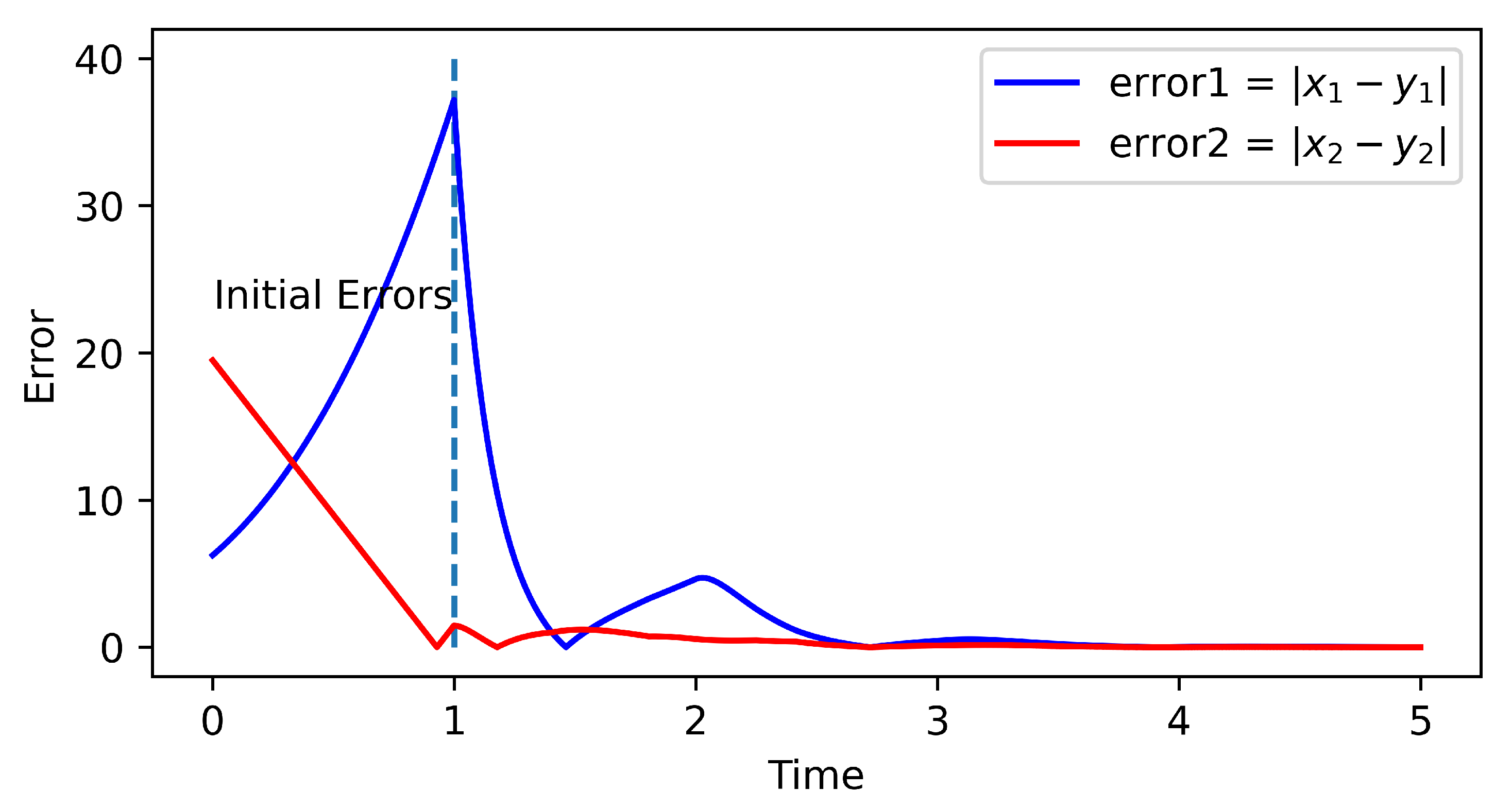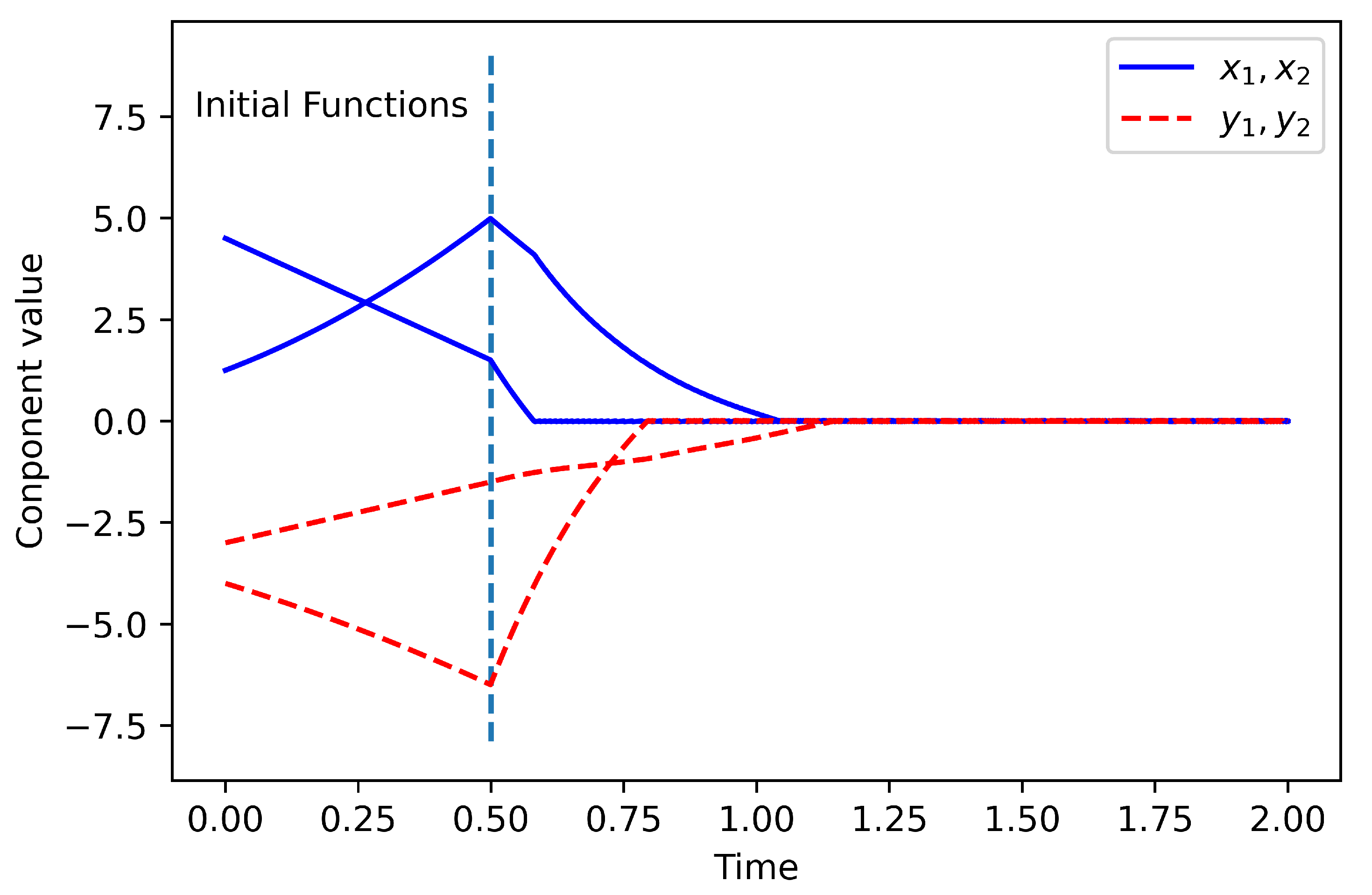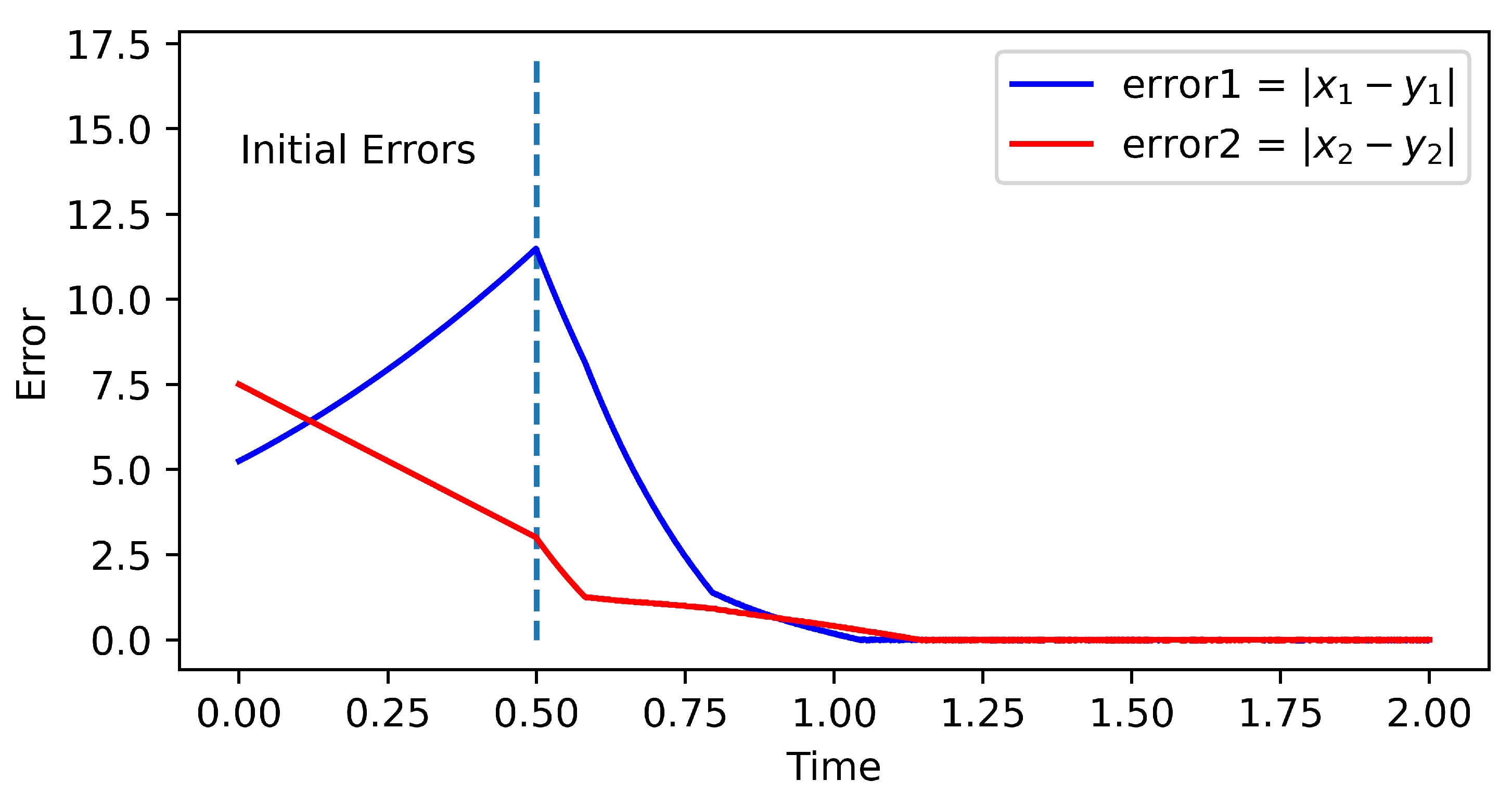Criteria on Exponential Incremental Stability of Dynamical Systems with Time Delay
Abstract
:1. Introduction
2. Preliminaries
- 1.
- The multiple norm is right-continuous at time t;
- 2.
- exists at time t.
3. Contraction Theory for Time-Delay Systems
- 1.
- is continuously differentiable with respect to x, and continuous with respect to except for the switching time points .
- 2.
- is upper bounded and has a positive lower bound for each k, and , .
- 3.
- is locally Lipschitz.
- 1.
- A constant ,
- 2.
- Positive constants , ,
- 3.
- for any ,
- 1.
- A constant ,
- 2.
- Positive constants , ,
- 3.
- for any ,
- 1.
- A constant ,
- 2.
- Positive constants ,
- 3.
- for any ,
4. Incremental Stability for Time-Delay Dynamical Systems with Discontinuous Right-Hand Sides
4.1. Existence and Uniqueness of the Solution
- 1.
- For any , is non-empty, convex, closed in , and set-valued mapping F is upper semicontinuous with respect to .
- 2.
- (Linearly increasing) There exists such thatholds for any . With Gronwall inequality [41], it can easily be seen as equivalent to: there exists such thatholds for any .
- 3.
- Function is continuously differentiable and bounded, with its upper bound and lower bound .
- 4.
- The initial function is measurable.
- 5.
- For any , there exists continuous function , such that holds.
- 1.
- ;
- 2.
- is continuous in ;
- 3.
- holds in ().
4.2. Criteria for Incremental Stability for Filippov Systems with Time Delay
- 1.
- is continuous and continuously differentiable with respect to , and continuous with respect to . Moreover, satisfies local Lipschitz conditions for .
- 2.
- For each and compact set ,holds, where and represents the Hausdorff metric. and are considered on , where , and so it is with .
- 3.
- For any compact set , there exists measure , defined as , in which represents the Lebesgue measure, q is a measurable function mapping to , such that holds for each and .
- 1.
- A constant ,
- 2.
- Positive constants , ,
- 3.
- for any ,
5. Applications
5.1. Linear Switched Time-Delay System
- 1.
- A constant ,
- 2.
- Positive constants , ,
- 3.
- for any ,
- 4.
- Matrix satisfying that and ,
- 1.
- A constant ,
- 2.
- Positive constants , ,
- 3.
- for any ,
5.2. Hopfield Neural Network Systems with Time Delay
- 1.
- There exists , , such that is continuous and holds for and .
- 2.
- is non-decreasing and non-trivial in any compact set in , and each has only finite discontinuous points. Therefore, in any compact set in , except a finite points , where there exist finite right and left limits and with , is continuous.
- 3.
- is non-decreasing and non-trivial in any compact set in , and each has only finite discontinuous points. Therefore, in any compact set in , except a finite points , where there exist finite right and left limits and with , is continuous.
- 4.
- Here, define a matrix measure for matrix , with respect to vector norm and matrix norm , where . There exists a positive diagonal matrixsuch thatholds for .
- 1.
- Positive piecewise right-continuous function ,
- 2.
- A constant ,
- 3.
- Positive constants ,
- 4.
- for any ,
6. Numerical Experiments
6.1. Linear Time-Delay System
6.2. Hopfield Neural Network with Time Delay
7. Conclusions
Author Contributions
Funding
Institutional Review Board Statement
Informed Consent Statement
Data Availability Statement
Acknowledgments
Conflicts of Interest
Notations
| Vector norm with subscript | |
| Matrix norm induced by | |
| Matrix measure induced by | |
| A right-continuous staircase function with respect to t, with switching points belonging to | |
| A piecewise right-continuous function with respect to t, with switching points | |
| The initial time | |
| The upper bound of : | |
| The lower bound of : | |
References
- Pavlov, A.; Pogromsky, A.; Wouw, N.V.D.; Nijmeijer, H. Convergent dynamics, a tribute to Boris Pavlovich Demidovich. Syst. Control Lett. 2004, 52, 257–261. [Google Scholar] [CrossRef]
- Rüffer, B.S. Convergent systems vs. incremental stability. Syst. Control Lett. 2013, 62, 277–285. [Google Scholar] [CrossRef]
- Fromion, V.; Scorletti, G.; Ferreres, G. Nonlinear performance of a PI controlled missile: An explanation. Int. J. Robust Nonlinear Control. IFAC-Affil. J. 1999, 9, 485–518. [Google Scholar] [CrossRef]
- Hamadeh, A.; Stan, G.B.; Sepulchre, R.; Goncalves, J. Global State Synchronization in Networks of Cyclic Feedback Systems. IEEE Trans. Autom. Control 2012, 57, 478–483. [Google Scholar] [CrossRef]
- Russo, G.; Di Bernardo, M. Correction to Section V-B of “Contraction Theory and the Master Stability Function: Linking Two Approaches to Study Synchronization in Complex Networks” [Feb 09 177-181]. Circuits Syst. Express Briefs IEEE Trans. 2014, 61, 915. [Google Scholar] [CrossRef]
- Kim, H.; Persis, C.D. Output synchronization of Lur’e-type nonlinear systems in the presence of input disturbances. IEEE Conf. Decis. Control 2015, 4145–4150. [Google Scholar]
- Promion, V. Some results on the behavior of Lipschitz continuous systems. In Proceedings of the 1997 European Control Conference (ECC), Brussels, Belgium, 1–7 July 1997; pp. 2011–2016. [Google Scholar]
- Lohmiller, W.; Slotine, J.J.E. On contraction analysis for non-linear systems. Automatica 1998, 34, 683–696. [Google Scholar] [CrossRef]
- Andronov, A.A.; Vitt, A.A.; Khaikin, S.E. Vibration Theory; Fizmatgiz: Moscow, Russia, 1959. (In Russian) [Google Scholar]
- Barbashin, E.A. Introduction to Stability Theory; Nauka: Moscow, Russia, 1967. (In Russian) [Google Scholar]
- Neimark, Y.I. Points Mapping Method in the Theory of Nonlinear Vibrations; Nauka: Moscow, Russia, 1972. (In Russian) [Google Scholar]
- Bautin, N.N.; Leontovich, E.A. Methods and Techniques of Qualitative Study of Dynamic Systems in a Plane; Nauka: Moscow, Russia, 1976. (In Russian) [Google Scholar]
- Gelig, A.K.; Leonov, G.A.; Yakubovich, V.A. Stability of Nonlinear Systems with Nonunique Equilibrium State; Nauka: Moscow, Russia, 1978. (In Russian) [Google Scholar]
- Filippov, A. Differential equations with discontinuous right-hand side. Am. Math. Soc. Transl. 1964, 42, 199–231. [Google Scholar]
- Filippov, A.F. Differential Equations with Discontinuous Right-Hand Sides; Kluwer Academic: Boston, MA, USA, 1988. [Google Scholar]
- Volterra, V. Sur la théorie mathématique des phénom enes héréditaires. J. Math. Pures Appl. 1928, 7, 249–298. [Google Scholar]
- Volterra, V. Theorie Mathematique de la Lutte Pour la vie; Gauthier-Villars: Paris, France, 1931. [Google Scholar]
- Hale, J.K.; Lunel, S.V. Introduction to Functional Differential Equations(Applied Mathematical Sciences, 99); Springer: Berlin, Germany, 1993. [Google Scholar]
- Cooke, K.L. Differential—Difference equations. In International Symposium on Nonlinear Differential Equations and Nonlinear Mechanics; Academic Press: Cambridge, MA, USA, 1963; pp. 155–171. [Google Scholar]
- Nihtilä, M.T. Analysis and synthesis of time delay systems: H. Gorechi, S. Fuksa, P. Grabowski and A. Korytowski. Automatica 1991, 27, 1065–1067. [Google Scholar] [CrossRef]
- Kaminogo, T. Kneser’s property and boundary value problems for some retarded functional differential equations. Tohoku Math. J. 1978, 30, 471–486. [Google Scholar] [CrossRef]
- Kaminogo, T. Topological properties of solution mappings in functional differential equations. Nonlinear Anal. Theory Methods Appl. 1997, 30, 871–876. [Google Scholar] [CrossRef]
- Tunç, C. Qualitative properties in nonlinear Volterra integro-differential equations with delay. J. Taibah Univ. Sci. 2017, 11, 309–314. [Google Scholar] [CrossRef]
- Deimling, K. Multivalued Differential Equations; De Gruyter: Berlin, Germany; New York, NY, USA, 1992. [Google Scholar]
- Haddad, T.; Haddad, T. Delay perturbed state-dependent sweeping process. Appl. Anal. 2016, 95, 270–282. [Google Scholar] [CrossRef]
- Marques, M.D.P.M.; Dzonou, R. Dynamics of a particle with friction and delay. Comptes Rendus Mec. 2017, 346, 237–246. [Google Scholar] [CrossRef]
- Pust, L.; Pešek, L. Influence of delayed excitation on vibrations of turbine blades couple. Appl. Comput. Mech. 2013, 7, 39–52. [Google Scholar]
- Smirnov, G.V. Introduction to the Theory of Differential Inclusions; University of Porto: Porto, Portugal, 2002. [Google Scholar]
- Ali, M.; Hou, Z.; Noori, M. Stability and performance of feedback control systems with time delays. Comput. Struct. 1998, 66, 241–248. [Google Scholar] [CrossRef]
- Callender, A.B.; Hartree, D.R.; Porter, A.R. Time-Lag in a Control System. Philos. Trans. R. Soc. A 1936, 235, 415–444. [Google Scholar]
- Haddad, G. Topological properties of the sets of solutions for functional differential inclusions. Nonlinear Anal. Theory Methods Appl. 1981, 5, 1349–1366. [Google Scholar] [CrossRef]
- Bacciotti, A.; Ceragioli, F. Optimal Regulation and Discontinuous Stabilization. IFAC Proc. Vol. 2001, 34, 39–44. [Google Scholar] [CrossRef]
- Lu, W.; Chen, T. Almost periodic dynamics of a class of delayed neural networks with discontinuous activations. Neural Comput. 2008, 20, 1065–1090. [Google Scholar] [CrossRef] [PubMed]
- Liu, X.; Cao, J. Synchronization control of discontinuous neural networks via approximation. In Proceedings of the 2010 Chinese Control and Decision Conference, Xuzhou, China, 26–28 May 2010; pp. 782–787. [Google Scholar]
- Fiore, D.; Hogan, S.J.; di Bernardo, M. Contraction analysis of switched systems via regularization. Automatica 2016, 73, 279–288. [Google Scholar] [CrossRef]
- Lu, W.; Bernardo, M. Contraction and incremental stability of switched Carathéodory systems using multiple norms. Automatica 2016, 70, 1–8. [Google Scholar] [CrossRef]
- Aubin, J.P.; Bayen, A.M.; Saint-Pierre, P. Viability Theory; Springer: Berlin/Heidelberg, Germany, 2009. [Google Scholar]
- Qiang, H.; Lu, W. The Coupling Mechanism and Dynamic Behavior of Complex Network Systems; Fudan University: Shanghai, China, 2021. [Google Scholar]
- Ortiz-Robinson, N.; Rios, V. Qualitative Properties of the Solution Set for Time-Delayed Discontinuous Dynamics. Set-Valued Var. Anal. 2020, 28, 327–344. [Google Scholar] [CrossRef]
- Liu, B.; Lu, W.; Chen, T. New conditions on synchronization of networks of linearly coupled dynamical systems with non-Lipschitz right-hand sides. Neural Netw. 2012, 25, 5–13. [Google Scholar] [CrossRef]
- Ortiz-Robinson, N.; Rios, V. Forward Euler Solutions and Weakly Invariant Time-Delayed Systems. Abstr. Appl. Anal. 2012, 3, 327–344. [Google Scholar] [CrossRef]
- Forti, M.; Nistri, P.; Papini, D. Global exponential stability and global convergence in finite time of delayed neural networks with infinite gain. IEEE Trans. Neural Netw. 2005, 16, 1449–1463. [Google Scholar] [CrossRef]
- Haddad, G. Monotone viable trajectories for functional differential inclusions. J. Differ. Equ. 1981, 42, 1–24. [Google Scholar] [CrossRef]




Disclaimer/Publisher’s Note: The statements, opinions and data contained in all publications are solely those of the individual author(s) and contributor(s) and not of MDPI and/or the editor(s). MDPI and/or the editor(s) disclaim responsibility for any injury to people or property resulting from any ideas, methods, instructions or products referred to in the content. |
© 2023 by the authors. Licensee MDPI, Basel, Switzerland. This article is an open access article distributed under the terms and conditions of the Creative Commons Attribution (CC BY) license (https://creativecommons.org/licenses/by/4.0/).
Share and Cite
Lang, Y.; Lu, W. Criteria on Exponential Incremental Stability of Dynamical Systems with Time Delay. Mathematics 2023, 11, 2242. https://doi.org/10.3390/math11102242
Lang Y, Lu W. Criteria on Exponential Incremental Stability of Dynamical Systems with Time Delay. Mathematics. 2023; 11(10):2242. https://doi.org/10.3390/math11102242
Chicago/Turabian StyleLang, Yingying, and Wenlian Lu. 2023. "Criteria on Exponential Incremental Stability of Dynamical Systems with Time Delay" Mathematics 11, no. 10: 2242. https://doi.org/10.3390/math11102242





